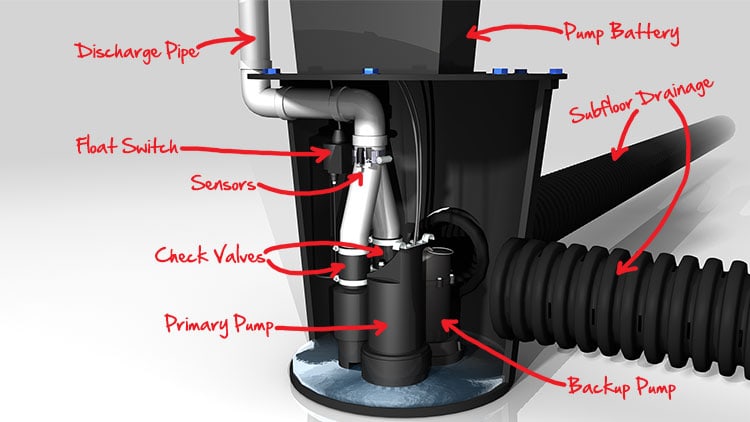Finding the Correct Sump Pump Setup

Share this Post
Any new home with a basement that floods often is a candidate for a sump pump setup, but sometimes the sump pump is not strong enough to handle local rainfall or super soakers. Sometimes, a house does not come with a sump pump at all. Owners of a new home are often left to wonder, “How is a flood possible in my new basement?”
Table of Contents
Sump Pump Setup Introduction
A basement waterproofing company is hired to install a new drainage system, floor, and sump pump setup but underestimates the amount of groundwater entering the drainage system. They may have installed a low horsepower sump pump unable to handle the water volume entering the system. The pump will always be on, eating away at electricity and not getting the job done. Worse yet, burning out the overworked pump led to a flooded basement, a problem it was supposed to solve in the first place.
The only way to avoid all these problems is to have a sump pump or pumps with the correct horsepower set in an appropriately sized sump basket. Only a skilled installer will know what you require to ensure your basement stays dry.
First, the installer must determine how much water enters your drainage system during peak rainfall. Several factors come into the equation; the depth of your basement and where it meets the hydrostatic line (water above this line will enter your drainage system), the type of soil (rocky, clay, or spongy) surrounding your house, and most importantly a familiarity with the area and the weather patterns.
It could rain 3 to 5 days in a row, producing enough groundwater to go way above the hydrostatic line. You get water that collects in the soft soil (backfill from construction) around your home and water that runs through underground capillaries from higher or lower elevations. Mother nature does not discriminate. It is the law of nature. We need to compensate to make sure we live within her laws.
Two or Three-Sump Pump Setup
Your basement waterproofing system is as strong as its weakest link. Replacing your sump pump(s) may not correct your flooding problem. The drainage system may be clogged or improperly installed. It may not be installed at the proper depth to capture the groundwater before it touches beneath your slab flooring. These are a few things to consider before installing a new sump pump setup.
If your basement waterproofing system is up to snuff, it is time to think about your sump pump set up and basket. A two-pump set is ideal for heavy downpours in bad drainage areas. They would be able to handle close to 8500 gallons an hour efficiently. However, the motors could burn out during a rainstorm and cause flooding if improperly installed.
Case in point, all three pumps are installed in an adequate basket to fit all three, but it is a tight fit. The basket will push up a float to activate the pumps whenever it fills. In turn, the pumps will drain the basket quickly and turn off. These pumps will turn on and off quickly because the basket is too small for the water displaced by the pumps. What is rated to be a 22-gallon basket is now a 10-gallon basket with all those pumps inside.
Sump Pump Wear & Tear
The vast amount of wear and tear on a pump is the initiation cycle (turning on). The lifespan of those pumps will be cut down dramatically with the undersized basket setup. Also, consider the proximity of the pumps; they are so close they will cause the activation floats to hang on one another. If this happens, one or two pumps might stay on even after all the water is pumped out. The activation float might remain in the “on” position until the pump burns out.
The best way to handle a two-pump setup is to place them in a large basket and well-spaced apart. Even though they are firmly secure, sump pumps vibrate and move slightly during operation. In a tight basket, the activation floats could entangle, but in a larger basket with proper spacing, there will be no chance of that happening.
Whether you require a one or two-pump setup, American Dry Basement Systems will guide you with the right fit for your home. We specialize in waterproof basement system installations in the Northeast (CT, NY, MA, RI, & NJ) and have the know-how to install the right system for your home and keep it dry for a lifetime.
Schedule a free, no-obligation inspection and quote at no cost.